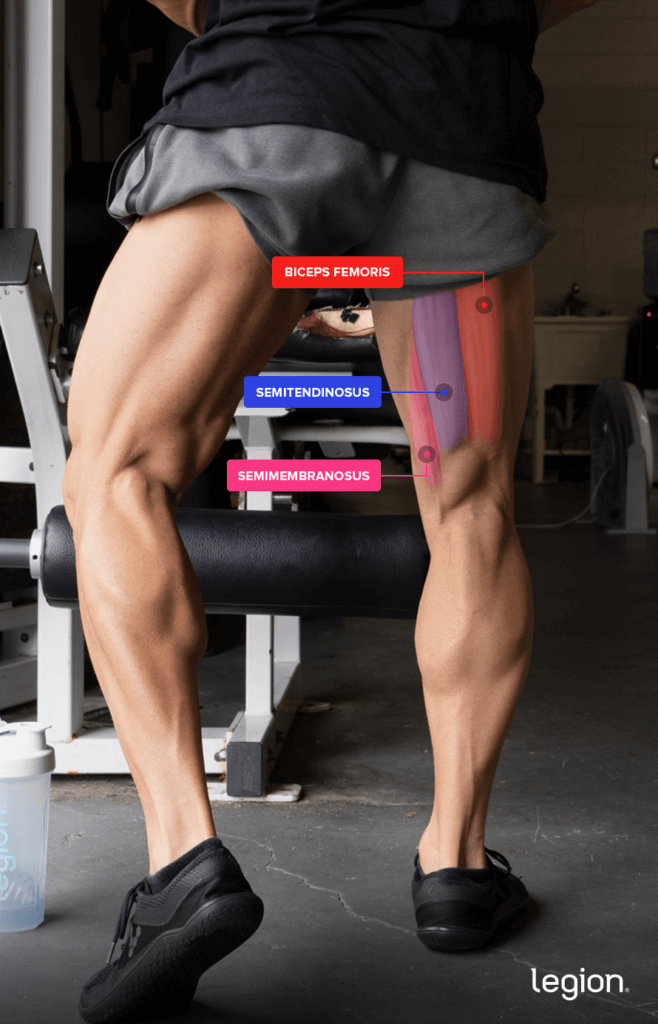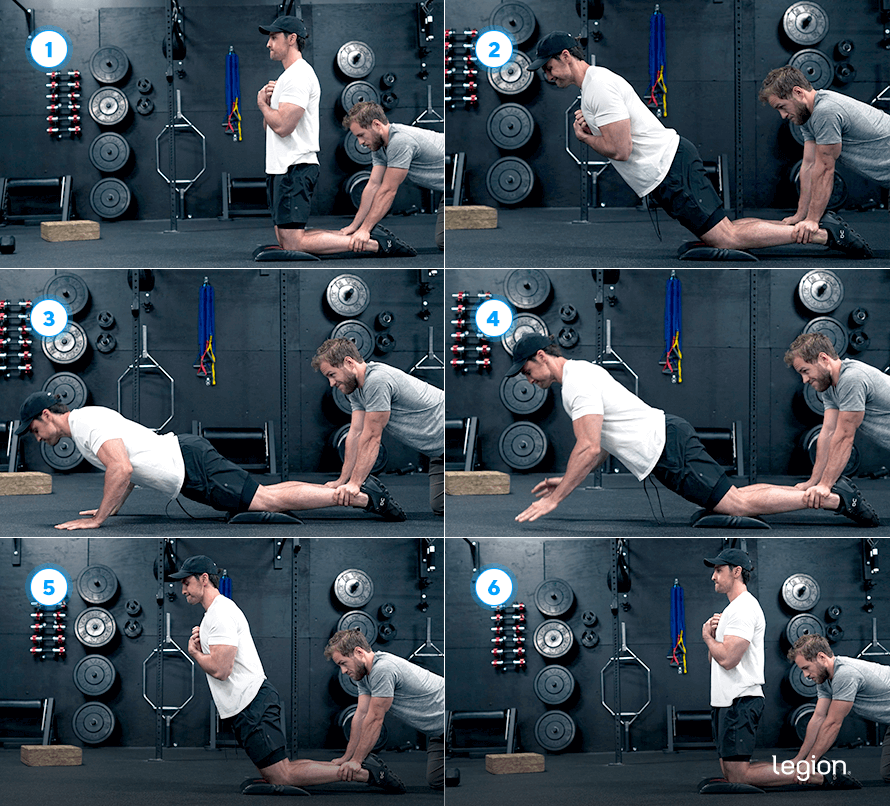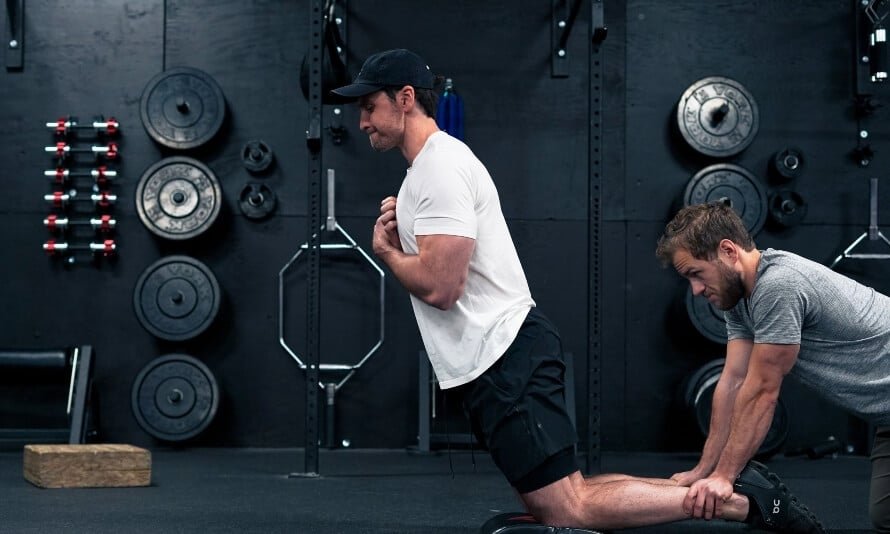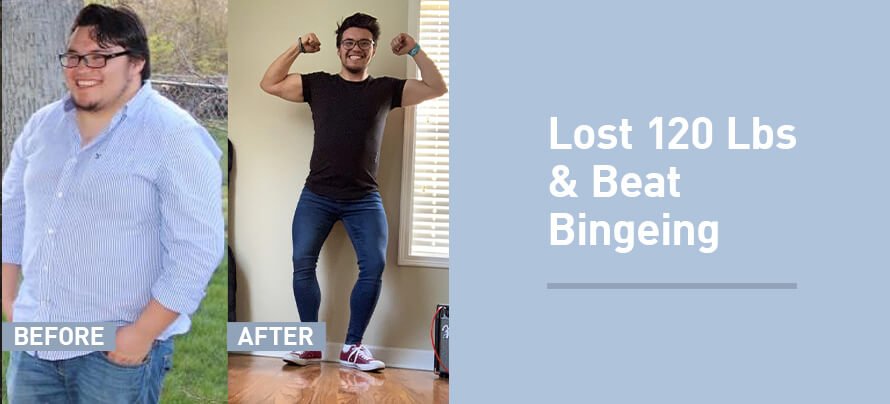[ad_1]
The Nordic hamstring curl is having a moment among athletes and coaches.
The two primary reasons for this are that it’s a simple exercise that you can do at home or at the gym without any special equipment, and it may also be particularly good at protecting the hamstrings against injuries.
In this article, you’ll learn what the Nordic hamstring curl is, why it’s beneficial, how to perform it with proper form, the best Nordic hamstring curl alternatives, and more.
What Is a Nordic Hamstring Curl?
The Nordic hamstring curl is a bodyweight exercise that primarily trains the hamstrings.
Typically, you perform it by kneeling on the floor and having a partner pin down your ankles, lowering your chest toward the floor by leaning forward, and lowering yourself in a controlled manner to the floor.
You then lift yourself back up by pressing off the floor with your arms and pulling with your hamstrings.
That said, there are several ways to perform the Nordic hamstring curl, many of which involve pieces of equipment that allow you to perform it more comfortably and without the assistance of a training partner.
Nordic Hamstring Curl Equipment
Here are some of the most common pieces of equipment used to perform the Nordic hamstring curl:
- Nordic Hamstring Curl Machine: A Nordic hamstring curl machine (usually referred to as a glute ham raise machine or GHD) is a metal frame with pads for your knees and feet. It allows you to perform the Nordic curl more comfortably because the knee pad supports your knees, and the foot pad locks your feet into position, making the exercise feel more stable.
- Nordic Hamstring Curl Bench: A Nordic hamstring curl bench is a flat bench with pads to support your knees and anchor your feet to the bench, enabling you to perform Nordic ham curls comfortably without a partner.
Nordic hamstring curl benches are relatively small, making them a good solution if you train at home and have limited space.
- Nordic Hamstring Curl Strap: A Nordic hamstring curl strap is a length of durable material (typically nylon) with a foot pad at one end and an “anchor” (usually made of rubber) at the other. To use it, you slip the strap under a door and trap it in place using the rubber anchor, then hook your feet under the foot pad.
Nordic hamstring curl straps offer less support than other Nordic hamstring curl equipment, but they’re also the cheapest, smallest, and lightest option, which means they’re ideal if you have a limited budget or like to train at home or while traveling.
Nordic Hamstring Curl: Benefits
Hamstring strains are the most common lower-body injury in athletes, particularly those who play sports requiring high-speed and explosive movements, such as sprinting, soccer, football, rugby, and basketball.
The main benefit of the Nordic curl is it decreases your risk of injury by increasing your hamstrings’ eccentric strength and fascicle length.
In other words, it trains your hamstrings to be strong in their lengthened position and it lengthens your hamstring’s muscle fibers, both of which make you significantly less likely (~51% less likely according to some research) to get injured while performing athletic movements, such as accelerating, decelerating, or changing direction at speed.
What’s more, studies suggest that the Nordic hamstring curl may also improve athletic performance by boosting agility, 10-meter sprint speed, and jump performance.
Nordic Hamstring Curl: Muscles Worked
The hamstrings are made up of three muscles: The semimembranosus, semitendinosus, and biceps femoris. The Nordic hamstring curl trains all three as well as the glutes, lower back, and calves to a lesser degree.
Here’s how the main muscles worked by the Nordic hamstring curl look on your body:

Nordic Hamstring Curl: Form
The best way to learn how to do a Nordic hamstring curl is to split the exercise into three parts: set up, descend, and curl.

1. Set up
Kneel on a yoga mat or cushioned pad facing away from your training partner and have your partner hold your legs around your ankles and pin your feet to the floor. Stand up straight so that your shoulders and hips are over your knees and your body forms a straight line from your head to your knees.
(You can also anchor your feet to the floor using specific Nordic hamstring curl equipment, such as a Nordic hamstring curl bench or strap, a loaded barbell, or by wedging your feet under something heavy like a sofa.)
Place your hands in front of your chest with your palms facing toward or away from you, depending on your preference.
2. Descend
While flexing your glutes, hamstrings, and abs and maintaining a straight line between your head and knees, lower your chest toward the floor by leaning forward, using your hamstrings to ensure the movement is slow and controlled.
As you near the floor, put your hands out to catch your body and prevent your chest from hitting the floor.
3. Curl
While maintaining the straight line between your head and knees, pull your body back to the starting position using your hamstrings. If necessary, push off the floor with your hands to initiate the curl.
The curl is a mirror image of what you did during the descent.
Nordic Hamstring Curl: Alternatives
1. Assisted Nordic Hamstring Curl
In the assisted Nordic hamstring curl, you wrap one end of a resistance band around something sturdy several feet above your head (a chin-up bar, for example) and the other around your chest. This means that the band supports some of your weight as you perform the exercise, effectively making your body lighter and the exercise easier to perform.
The benefit of the assisted Nordic hamstring curl is that it allows you to train your hamstrings with a similar movement to the regular Nordic curl, even when you’re not strong enough to do the exercise with your body weight. This helps you develop the strength you need to perform Nordic curls unaided.
2. Razor Curl
The razor curl is a bodyweight exercise that trains the hamstrings and glutes similarly to the Nordic curl. The downside of the razor curl is that it requires a glute ham developer, or GHD, which is a specialized piece of equipment that few commercial gyms have.
3. Seated Leg Curl
The leg curl is a great exercise for strengthening your hamstrings, especially the biceps femoris and semitendinosus muscles. Furthermore, because it involves a machine, it’s easier to learn and perform than the Nordic hamstring curl, making it a good option for people who are new to weightlifting and don’t have the strength to perform the Nordic curl (yet!).
FAQ #1: Can you make a DIY Nordic hamstring curl machine?
Yes.
To do the Nordic hamstring curl at home, secure your feet under something heavy like a bed or couch and kneel on something soft, like a yoga mat, blanket, or pillow, and perform the exercise as normal.
FAQ #2: What’s the best Nordic hamstring curl progression?
A Nordic hamstring curl progression is a series of exercises that help you progress from not being able to do a Nordic curl to doing your first Nordic curl with proper form.
Here’s my favorite Nordic hamstring curl progression:
1. Seated Leg Curls: The leg curl will help you build the necessary strength to progress to Nordic hamstring curl variations.
2. Assisted Nordic Hamstring Curls: Using a band to support some of your body weight makes the exercise easier and allows you to train your hamstrings with an exercise that closely mimics the bodyweight Nordic curl, which helps you build the strength you need to perform the exercise unaided.
Once you can do 3 sets of 15 reps, you should be strong enough to move onto bodyweight Nordic curls.
3. Bodyweight Nordic Hamstring Curls: Initially, you’ll probably have to use your arms to push off the floor to complete reps of the Nordic hamstring curl. Over time, try to rely less on this assistance and more on the strength of your hamstrings to pull yourself to the starting position.
For most people, the bodyweight Nordic curl will never be “easy,” so there’s no reason to progress further. However, if you can do 3 sets of 15 reps with minimal (or no) assistance from your arms, progress to the weighted Nordic hamstring curl.
4. Weighted Nordic Hamstring Curls: The best way to perform the weighted Nordic hamstring curl is with a weighted vest or a backpack filled with weights. If you don’t have a weighted vest available, you can clasp a weight plate to your chest. Be aware, however, that if you’re holding a weight plate, you can’t prevent your body from falling forward with your hands if things go pear-shaped.
FAQ #3: Glute Ham Raise vs. Nordic Curl: Which is better?
It depends.
In the Nordic hamstring curl, your feet and knees are in line with each other (both on the floor), whereas in the glute ham raise, the knee pad places your knees slightly below your feet. This means that the “lever arm” (in this case, your torso and thighs) is slightly longer in the Nordic curl, which is why the Nordic curl feels more challenging than the glute ham raise.
As such, people use each exercise to achieve different results.
Athletes tend to favor the Nordic hamstring curl because it focuses on training the hamstrings eccentrically (as they lengthen), which is important for preventing injuries and improving athletic performance.
However, people who want to build muscle tend to favor the glute ham raise because it places less emphasis on the eccentric (lowering) portion of the exercise, and more emphasis on the concentric (lifting) portion, which is generally preferable for muscle growth.
+ Scientific References
- Ekstrand, J., Hägglund, M., & Waldén, M. (2011). Injury incidence and injury patterns in professional football: the UEFA injury study. British Journal of Sports Medicine, 45(7), 553–558. https://doi.org/10.1136/BJSM.2009.060582
- Malliaropoulos, N., Isinkaye, T., Tsitas, K., & Maffulli, N. (2011). Reinjury after acute posterior thigh muscle injuries in elite track and field athletes. The American Journal of Sports Medicine, 39(2), 304–310. https://doi.org/10.1177/0363546510382857
- Ekstrand, J., Hägglund, M., & Waldén, M. (2011). Epidemiology of muscle injuries in professional football (soccer). The American Journal of Sports Medicine, 39(6), 1226–1232. https://doi.org/10.1177/0363546510395879
- Feeley, B. T., Kennelly, S., Barnes, R. P., Muller, M. S., Kelly, B. T., Rodeo, S. A., & Warren, R. F. (2008). Epidemiology of National Football League training camp injuries from 1998 to 2007. The American Journal of Sports Medicine, 36(8), 1597–1603. https://doi.org/10.1177/0363546508316021
- Brooks, J. H. M., Fuller, C. W., Kemp, S. P. T., & Reddin, D. B. (2006). Incidence, Risk, and Prevention of Hamstring Muscle Injuries in Professional Rugby Union. Https://Doi.Org/10.1177/0363546505286022, 34(8), 1297–1306. https://doi.org/10.1177/0363546505286022
- Borowski, L. A., Yard, E. E., Fields, S. K., & Comstock, R. D. (2008). The epidemiology of US high school basketball injuries, 2005-2007. The American Journal of Sports Medicine, 36(12), 2328–2335. https://doi.org/10.1177/0363546508322893
- Timmins, R. G., Bourne, M. N., Shield, A. J., Williams, M. D., Lorenzen, C., & Opar, D. A. (2016). Short biceps femoris fascicles and eccentric knee flexor weakness increase the risk of hamstring injury in elite football (soccer): a prospective cohort study. British Journal of Sports Medicine, 50(24), 1524–1535. https://doi.org/10.1136/BJSPORTS-2015-095362
- Jones, P. A., Thomas, C., Dos’santos, T., McMahon, J. J., & Graham-Smith, P. (2017). The Role of Eccentric Strength in 180° Turns in Female Soccer Players. Sports, 5(2). https://doi.org/10.3390/SPORTS5020042
- Hody, S., Croisier, J. L., Bury, T., Rogister, B., & Leprince, P. (2019). Eccentric Muscle Contractions: Risks and Benefits. Frontiers in Physiology, 10(MAY). https://doi.org/10.3389/FPHYS.2019.00536
- Van Dyk, N., Behan, F. P., & Whiteley, R. (2019). Including the Nordic hamstring exercise in injury prevention programmes halves the rate of hamstring injuries: a systematic review and meta-analysis of 8459 athletes. British Journal of Sports Medicine, 53(21), 1362–1370. https://doi.org/10.1136/BJSPORTS-2018-100045
- Siddle, J., Weaver, K., Greig, M., Harper, D., & Brogden, C. M. (2022). A low-volume Nordic hamstring curl programme improves change of direction ability, despite no architectural, strength or speed adaptations in elite youth soccer players. Https://Doi.Org/10.1080/15438627.2022.2079984. https://doi.org/10.1080/15438627.2022.2079984
- Anastasi, S. M., & Hamzeh, M. A. (2011). Does the eccentric Nordic Hamstring exercise have an effect on isokinetic muscle strength imbalance and dynamic jumping performance in female rugby union players? Isokinetics and Exercise Science, 19(4), 251–260. https://doi.org/10.3233/IES-2011-0420
- Clark, R., Bryant, A., Culgan, J. P., & Hartley, B. (2005). The effects of eccentric hamstring strength training on dynamic jumping performance and isokinetic strength parameters: A pilot study on the implications for the prevention of hamstring injuries. Physical Therapy in Sport, 6(2), 67–73. https://doi.org/10.1016/J.PTSP.2005.02.003
- Krommes, K., Petersen, J., Nielsen, M. B., Aagaard, P., Hölmich, P., & Thorborg, K. (2017). Sprint and jump performance in elite male soccer players following a 10-week Nordic Hamstring exercise Protocol: a randomised pilot study. BMC Research Notes, 10(1), 669. https://doi.org/10.1186/S13104-017-2986-X
- Bautista, I. J., Vicente-Mampel, J., Baraja-Vegas, L., Segarra, V., Martín, F., & Van Hooren, B. (2021). The effects of the Nordic hamstring exercise on sprint performance and eccentric knee flexor strength: A systematic review and meta-analysis of intervention studies among team sport players. Journal of Science and Medicine in Sport, 24(9), 931–938. https://doi.org/10.1016/J.JSAMS.2021.03.009
- Afonso, J., Rocha-Rodrigues, S., Clemente, F. M., Aquino, M., Nikolaidis, P. T., Sarmento, H., Fílter, A., Olivares-Jabalera, J., & Ramirez-Campillo, R. (2021). The Hamstrings: Anatomic and Physiologic Variations and Their Potential Relationships With Injury Risk. Frontiers in Physiology, 12, 694604. https://doi.org/10.3389/FPHYS.2021.694604
- Oliver, G. D., & Dougherty, C. P. (2009). The razor curl: a functional approach to hamstring training. Journal of Strength and Conditioning Research, 23(2), 401–405. https://doi.org/10.1519/JSC.0B013E31818F08D0
- Oliver, G. D., Stone, A. J., Wyman, J. W., & Blazquez, I. N. (n.d.). Muscle activation of the torso during the modified razor curl hamstring exercise – PubMed. Retrieved April 3, 2023, from https://pubmed.ncbi.nlm.nih.gov/22319680/
- Oliver, G. D., & Dougherty, C. P. (2009). Comparison of hamstring and gluteus muscles electromyographic activity while performing the razor curl vs. the traditional prone hamstring curl. Journal of Strength and Conditioning Research, 23(8), 2250–2255. https://doi.org/10.1519/JSC.0B013E3181B8D34B
- Yanagisawa, O., & Fukutani, A. (n.d.). Section I-Kinesiology Muscle Recruitment Pattern of The Hamstring Muscles in Hip Extension and Knee Flexion Exercises. Journal of Human Kinetics, 72(2020), 51–59. https://doi.org/10.2478/hukin-2019-0124
[ad_2]
Source link



